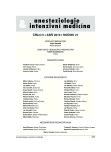Spontaneous delivery during ECMO for H1N1 pneumonia-related ARDS – case report
Authors:
Kunstýř Jan 1; Lipš Michal 1; Bělohlávek Jan 2; Prskavec Tomáš 3; Mlejnský František 3; Koucký Michal 4; Sebroň Václav 4; Stříteský Martin 1; Bartáková Hana 1; Balík Martin 1
Authors‘ workplace:
Klinika anestezie, resuscitace a intenzivní medicíny, VFN Praha
1; II. interní klinika, VFN Praha
2; II. chirurgická klinika kardiovaskulární chirurgie, VFN Praha
3; Gynekologicko-porodnická klinika, VFN Praha
4
Published in:
Anest. intenziv. Med., 21, 2010, č. 5, s. 258-261
Category:
Intesive Care Medicine - Case Report
Overview
Authors present a case report of a woman in the 24th week of pregnancy who acquired intractable swine influenza-related ARDS. Failing conventional ICU therapy including aggressive mechanical ventilation, she was transferred to an ECMO centre where veno-venous (VV) ECMO provided oxygenation and ventilation together with the sanation of the lung injury and barotrauma. Thirty hours post commencing the VV-ECMO she spontaneously delivered. Besides a temporary cessation of the heparin infusion the delivery did not require special measures or changes to the ECMO therapy. The authors discuss the peri-partum issues in pregnant women suffering from severe respiratory failure on VV-ECMO. Complex ultrasound monitoring is highly recommended.
Keywords:
extracorporeal membrane oxygenation – ARDS – influenza type A – delivery
Sources
1. Peek, G. J., Mugford, M., Tiruvoipati, R. et al. Efficacy and economic assessment of conventional ventilatory support versus extracorporeal membrane oxygenation for severe adult respiratory failure (CESAR): a multicentre randomised controlled trial. Lancet, 2009, 374, p. 1351–1363.
2. Davies, A., Jones, D., Balley, M. et al (The Australia and New Zealand Extracorporeal Membrane Oxygenation Influenza Investigators) Extracorporeal Membrane Oxygenation for 2009 influenza A(H1N1) Acute Respiratory Distress Syndrome. JAMA, 2009, 302, 17, p. 1888–1895.
3. Seppelt, I. et al. Critical illness due to 2009 A/H1N1 influenza in pregnant and postpartum women: population based cohort study. BMJ, 2010, 340, p. 1279.
4. Lapinsky, S. E. H1N1 novel influenza A in pregnant an immunocompromised patients. Crit. Care Med., 2010, 38, p. e52–57.
5. Siston, A. M. et al. Pandemic influenza A (H1N1) virus illness among pregnant women in the United States. JAMA, 2010, 303, p. 1517–1525.
6. Hewagama, S., Walker, S. P., Stuart, R. L. et al. 2009 H1N1 Influenza A and Pregnancy Outcomes in Victoria, Australia. Clin. Infect. Dis., 2010, 50, p. 686–690.
7. Wheeler, A. P., Bernard, G. R. Acute lung injury and the acute respiratory distress syndrome: a clinical review. Lancet, 2007, 369, p. 1553–1565.
8. Simhan, N. H., Cartinis, S. N. Prevention preterm delivery. N. Engl. J. Med., 2007, 357, p. 477–487.
9. Lockwood, C. J., Kuczynski, E. Risk stratification and pathological mechanisms in preterm delivery. Paediatr. Perinat. Epidemiol., 2001, 15, Suppl 2, p. 78–89.
10. Hájek, Z. a kol. Rizikové a patologické těhotenství. Praha: Grada 2004.
11. Sanchez-Ramos, L., Delke, I., Zamora, J., Kaunitz, A. M. Fetal fibronectin as a short-term predictor of preterm birth in symptomatic patients: a meta-analysis. Obstet. Gynecol., 2009, 114, 3, p. 631–640.
12. Balik, M., Plasil, P., Waldauf, P., Pazout, J., Fric, M., Otahal, M., Pachl, J. Ultrasound estimation of volume of pleural fluid in mechanically ventilated patients. Intensive Care Med., 2006, 32, 2, p. 318–321.
13. Guillorya, R. K., Gunter, O. L. Ultrasound in the surgical intensive care unit. Current Opinion in Critical Care, 2008, 14, p. 415–422.
Labels
Anaesthesiology, Resuscitation and Inten Intensive Care MedicineArticle was published in
Anaesthesiology and Intensive Care Medicine

2010 Issue 5
Most read in this issue
- Recombinant activated factor VII (rFVIIa) in the treatment of life threatening post-partum haemorrhage – data from the UniSeven clinical registry in the Czech Republic
- Application of recombinant factor VIIa for refractory bleeding in patients with liver trauma – case reports
- Effect of early use of high frequency oscillation in children with respiratory failure
- Spontaneous delivery during ECMO for H1N1 pneumonia-related ARDS – case report
